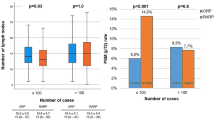Abstract
Radical prostatectomy is the treatment of choice for management of organ-confined prostate cancer. Minimally invasive treatments, as an alternative, have refined been recently by the introduction of da Vinci robotic technology which has the potential to improve surgical outcomes and reduce the steep learning curve associated with conventional laparoscopic radical prostatectomy. We report on our experience with robotic radical prostatectomy using the first da Vinci robotic system in our country. During 8 months, 40 robotic radical prostatectomies were performed by a single surgical team at Athens Medical Centre (Marousi, Greece). Preoperative data collection included basic demographics, prostate-specific antigen (PSA), clinical stage, and Gleason score. Operative outcomes included operative time, estimated blood loss, and complications. Postoperative outcomes included hospital stay, pain, catheter time, pathology, PSA, return of continence, and potency. Average operative time was 186.25 min with an estimated mean blood loss of 135 ml. There were no intra-operative complications. Ninety per cent of the patients were discharged home on postoperative day 1 with mean haematocrit 36.7 (range 29–43). All patients reported minimal postoperative pain and resumed regular diet on the first postoperative day. Average catheter time was 6.6 days (range 5–10). Early continence was observed in 47.5% of the patients, seven days after catheter removal. Continence at 1, 3, and 6 months was 75, 82.5 and 95%, respectively. The overall positive margin rate was 17.5%. Ninety-five per cent of the patients had undetectable postoperative PSA levels (less than 0.1 ng/ml) at a median follow-up of 6 months. Our initial experience with robotic radical prostatectomy is very promising. The learning curve was approximately 10–12 cases. With a methodical approach we were able to implement the method safely and effectively in our practice, combining minimal morbidity with good oncological and functional outcomes.
Similar content being viewed by others

References
Ahlering TE, Eichel L, Chou D, Skarecky DW (2005) Feasibility study for robotic radical prostatectomy cautery-free neurovascular bundle preservation. Urology 65(5):994–997
Van Velthoven RF, Ahlering TE, Peltier A et al (2003) Technique for laparoscopic running urethrovesical anastomosis: the single knot method. Urology 61:699–702
Rocco F, Carmignani L, Acquati P et al (2007) Early continence recovery after open radical prostatectomy with restoration of the posterior aspect of the rhabdosphincter. Eur Urol 52(2):376–383
Tewari AK, Bigelow K, Rao S et al (2007) Anatomic restoration technique of continence mechanism and preservation of puboprostatic collar: a novel modification to achieve early urinary continence in men undergoing robotic prostatectomy. Urology 69(4):726–731
Takenaka A, Tewari AK, Leung RA et al (2007) Preservation of the puboprostatic collar and puboperineoplasty for early recovery of urinary continence after robotic prostatectomy: anatomic basis and preliminary outcomes. Eur Urol 51(2):433–440
Ficarra V, Cavalleri S, Novara G et al (2007) Evidence from robot-assisted laparoscopic radical prostatectomy: a systematic review. Eur Urol 51(1):45–55
Patel VR, Thaly R, Shah K (2007) Robotic radical prostatectomy: outcomes of 500 cases. BJU Int 99(5):1109–1112
Menon M, Tewari A, Peabody JO et al (2004) Vattikuti Institute prostatectomy, a technique of robotic radical prostatectomy for management of localized carcinoma of the prostate: experience of over 1100 cases. Urol Clin North Am 31:701–717
Menon M, Shrivastava A, Kaul S et al (2007) Vattikuti institute prostatectomy: contemporary technique and analysis of results. Eur Urol 51:648–658
Menon M, Tewari A, Vattikuti Institute Prostatectomy Team (2003) Robotic radical prostatectomy and the Vattikuti Urology Technique: an interim analysis of results and technical points. Urol Suppl 61:15
Menon M, Kaul S, Bhandari A et al (2005) Potency following robotical radical prostatectomy: a questionnaire based analysis of outcomes after conventional nerve sparing and prostatic fascia sparing techniques. J Urol 174:2291
Ahlering TE, Woo D, Eichel L et al (2004) Robot assisted versus open radical prostatectomy: a comparison of one surgeon’s outcome. Urology 63:819
Farnham SB, Webster TM, Herrell SD, Smith JA (2006) Intraoperative blood loss and transfusion requirements for robotic assisted radical prostatectomy versus radical retropubic prostatectomy. Urology 67(2):360–363
Nelson B, Kaufman M, Broughton G et al (2007) Comparison of length of hospital stay between radical retropubic prostatectomy and robotic assisted laparoscopic prostatectomy. J Urol 177(3):929–931
Carlsson S, Nilsson AE, Wiklund PN (2006) Postoperative urinary continence after robot-assisted laparoscopic radical prostatectomy. Scand J Urol Nephrol 40(2):103–107
Nilsson AE, Carlsson S, Laven BA, Wiklund PN (2006) Karolinska prostatectomy: a robot-assisted laparoscopic radical prostatectomy technique. Scand J Urol Nephrol 40(6):453–458
Hoznek A, Menard Y, Salomon L, Abbou CC (2005) Update on laparoscopic and robotic radical prostatectomy. Curr Opin Urol 15(3):173–180
Mikhail AA, Stockton BR, Orvieto MA et al (2006) Robotic-assisted laparoscopic prostatectomy in overweight and obese patients. Urology 67(4):774–779
Box GN, Ahlering TE (2008) Robotic radical prostatectomy: long term outcomes. Curr Opin Urol 18(2):173–179
Tewari A, Jhaveri J, Rao S et al (2008) Total reconstruction of the vesico-urethral junction. BJU Int 101(7):871–877
Nguyen MM, Kamoi K, Stein RJ et al (2008) Early continence outcomes of posterior musculofascial plate reconstruction during robotic and laparoscopic prostatectomy. BJU Int 101(9):1135–1139
Tewari A, Peabody JO, Fischer M et al (2003) An operative and anatomic study to help in nerve sparing during laparoscopic and robotic radical prostatectomy. Eur Urol 43(5):444–454
Coughlin G, Palmer KJ, Shah K, Patel VR (2007) Robotic-assisted radical prostatectomy: functional outcomes. Arch Esp Urol 60(4):408–418
Author information
Authors and Affiliations
Corresponding author
Rights and permissions
About this article
Cite this article
Pardalidis, N.P., Andriopoulos, N.A., Tsiga, A. et al. Robotic radical prostatectomy in Greece: the learning curve and beyond. The initial 40 cases. J Robotic Surg 2, 77–80 (2008). https://doi.org/10.1007/s11701-008-0092-8
Received:
Accepted:
Published:
Issue Date:
DOI: https://doi.org/10.1007/s11701-008-0092-8



